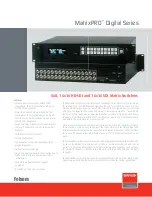
DGS-3130 Series Layer 3 Stackable Managed Switch Web UI Reference Guide
475
To assign the
802.1p Default Priority
by the RADIUS server, the proper parameters should be configured on the
RADIUS server. The table below shows the parameters for 802.1p default priority.
The parameters of the Vendor-Specific attributes are:
Vendor-Specific Attribute Description
Value
Usage
Vendor-ID
Defines the vendor.
171 (DLINK) Required
Vendor-Type
Defines the attribute.
4
Required
Attribute-Specific Field
Used to assign the 802.1p default priority of the port.
0 to 7
Required
If the user has configured the 802.1p priority attribute of the RADIUS server (for example, priority 7) and the 802.1X,
or MAC based authentication is successful, the device will assign the 802.1p default priority (according to the RADIUS
server) to the port. However, if the user does not configure the priority attribute and authenticates successfully, the
device will not assign a priority to this port. If the priority attribute is configured on the RADIUS server is a value out of
range (>7), it will not be set to the device.
To assign the
VLAN
by the RADIUS server, the proper parameters should be configured on the RADIUS server. To
use VLAN assignment, RFC 3580 defines the following tunnel attributes in RADIUS packets.
The table below shows the parameters for a VLAN:
RADIUS
Tunnel
Attribute
Description
Value
Usage
Tunnel-Type
This attribute indicates the tunneling protocol(s) to be used (in the
case of a tunnel initiator) or the tunneling protocol in use (in the case
of a tunnel terminator).
13
(VLAN)
Required
Tunnel-
Medium-Type
This attribute indicates the transport medium being used.
6 (802)
Required
Tunnel-Private-
Group-ID
This attribute indicates group ID for a particular tunneled session.
A string
(VID)
Required
A summary of the Tunnel-Private-Group-ID Attribute format is shown below.
0 1 2 3
0 1 2 3 4 5 6 7 8 9 0 1 2 3 4 5 6 7 8 9 0 1 2 3 4 5 6 7 8 9 0 1
+-+-+-+-+-+-+-+-+-+-+-+-+-+-+-+-+-+-+-+-+-+-+-+-+-+-+-+-+-+-+-+-+
| Type | Length | Tag | String...
+-+-+-+-+-+-+-+-+-+-+-+-+-+-+-+-+-+-+-+-+-+-+-+-+-+-+-+-+-+-+-+-+
The table below shows the definition of Tag field (different with RFC 2868):
Tag field
value
String field format
0x01
VLAN name (ASCII)
0x02
VLAN ID (ASCII)
Others
(0x00, 0x03
~ 0x1F,
>0x1F)
When the Switch receives the VLAN setting string, it will think it is the VLAN ID first. In other
words, the Switch will check all existing VLAN IDs and check if there is one matched. If the
Switch can find one matched, it will move to that VLAN. If the Switch cannot find the matched
VLAN ID, it will think the VLAN setting string as a “VLAN Name”. Then it will check that it can find
out a matched VLAN Name.
Summary of Contents for DGS-3130 Series
Page 1: ......




































